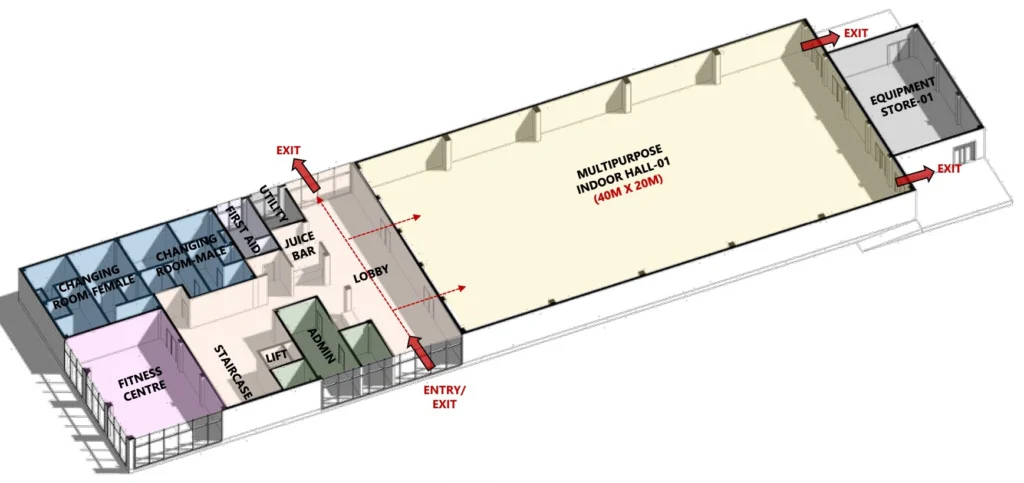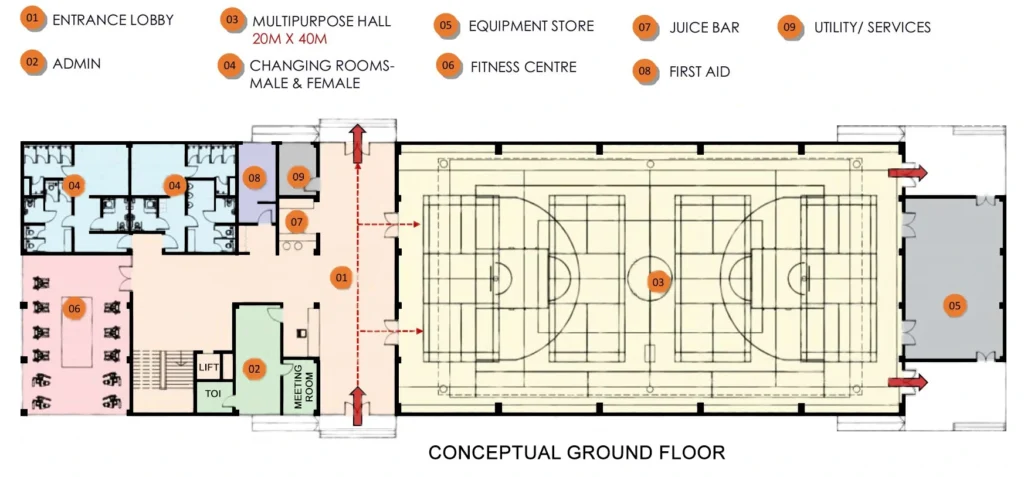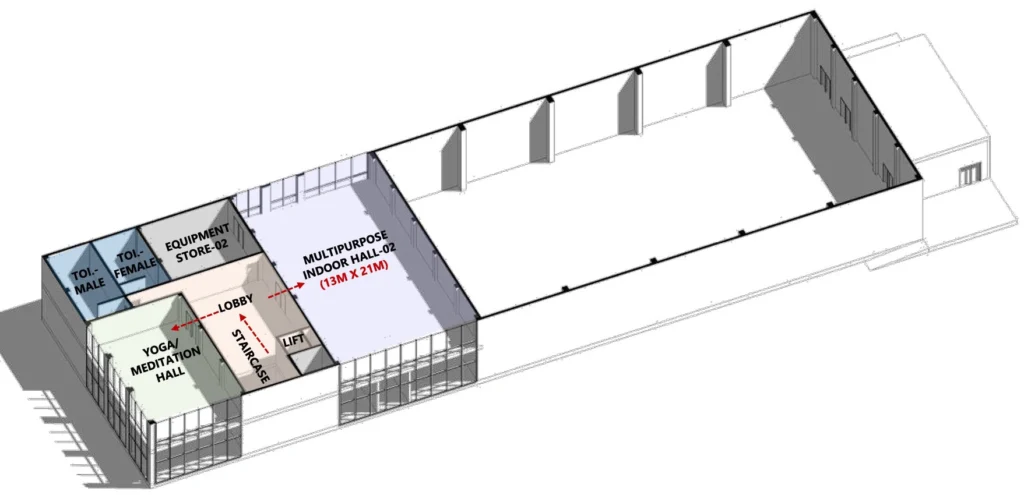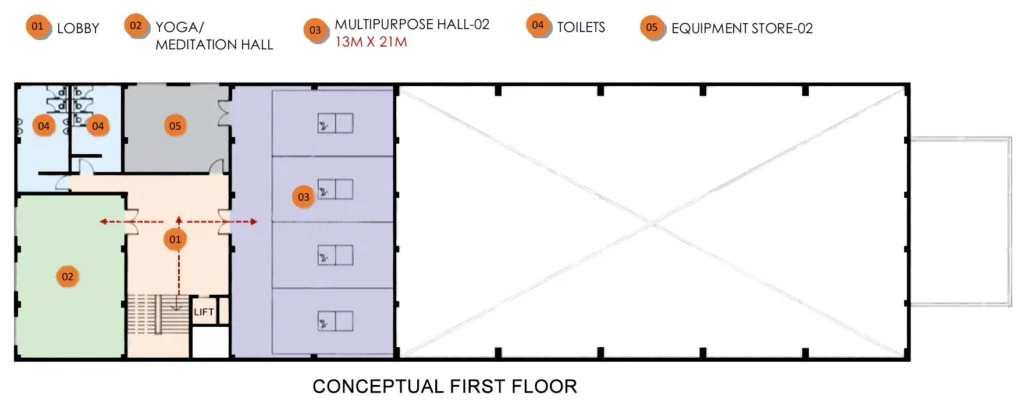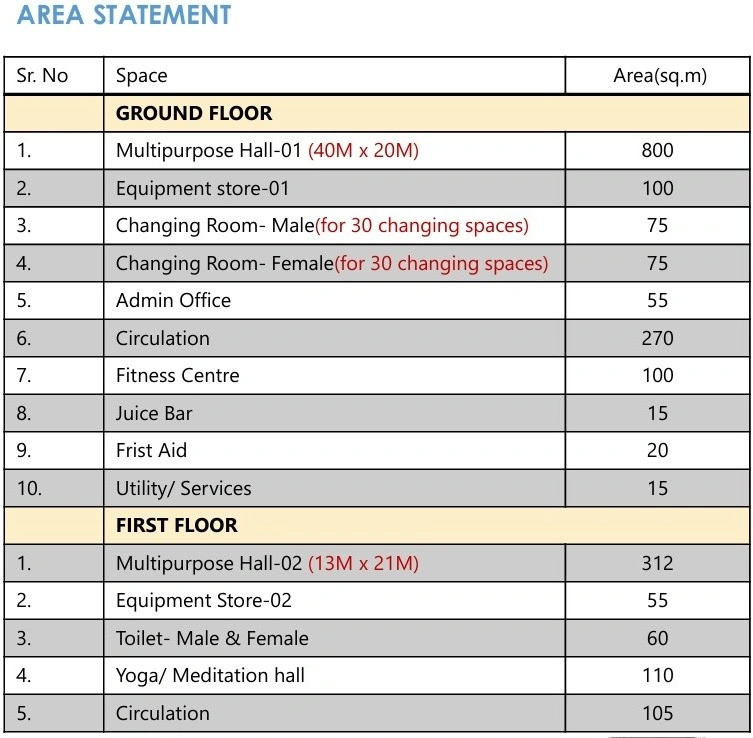A multipurpose sports hall is a versatile facility designed to accommodate a wide range of sports and recreational activities. Unlike single-purpose sports venues, these halls are adaptable and can host various sports such as basketball, volleyball, badminton, indoor football, and even non-sporting events like exhibitions and concerts.
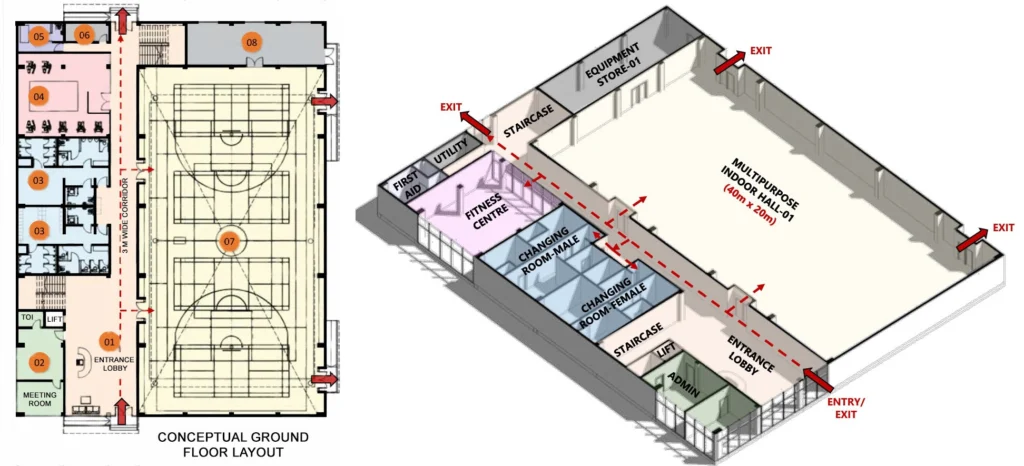
Key features of a multipurpose sports hall include:
- Flexible flooring systems that cater to different sports.
- Adjustable seating arrangements to accommodate spectators.
- Advanced lighting and ventilation to enhance player experience.
- Modular partitions and retractable equipment for easy conversion between sports.
These halls are essential in urban and educational settings, providing a cost-effective, space-efficient solution for sporting activities.
If you want to know about the Types of slabs or Permeable concrete or Islamic architecture, please click the link.
1) Importance of Versatile Sports Facilities
Versatility in sports facilities is critical for maximizing space utilization, increasing accessibility, and promoting inclusivity. Some of the main reasons why versatile sports halls are necessary include:
- Maximizing Space Efficiency – Instead of constructing separate venues for different sports, a multipurpose sports hall allows multiple activities in the same space.
- Catering to Various Sports and Events – A single venue can support competitive matches, training sessions, fitness programs, and even community events.
- Encouraging Community Engagement – These halls provide opportunities for schools, local clubs, and communities to engage in recreational activities.
- Enhancing Financial Viability – A facility that can host different events ensures continuous revenue generation.
2) Key Design Considerations for a MSH
Designing a multipurpose sports hall requires careful planning to ensure functionality, durability, and accessibility. Three essential factors to consider are space utilization and adaptability, structural durability and safety compliance, and accessibility and user-friendliness.
i) Space Utilization and Adaptability
One of the biggest challenges in designing a multipurpose sports hall is ensuring that the available space can be effectively used for various sports and activities. Key Strategies for Space Optimization:
- Zoning Different Activity Areas – Clearly defining spaces for different sports while maintaining flexibility for quick transitions.
- Movable Partitions & Retractable Equipment – Using modular walls and retractable seating to reconfigure the hall for different events.
- Storage Solutions – Well-designed storage spaces for sports gear, seating, and other equipment to keep the playing area uncluttered.
- Dual-Purpose Flooring – Installing high-performance flooring suitable for multiple sports to avoid the need for surface changes.
- Multi-Level Layouts – Incorporating mezzanine levels or spectator stands to maximize vertical space.
By prioritizing adaptability, a multipurpose sports hall can host everything from professional matches to community events, making it a cost-effective and highly functional facility.
ii) Objective
The primary objective of designing a multipurpose sports hall is to create a versatile, functional, and inclusive space that caters to a wide range of sports, recreational activities, and community events. A well-designed facility should meet the needs of athletes, spectators, and event organizers while ensuring efficiency, safety, and sustainability. Key Objectives of a Multipurpose Sports Hall Design given below.
- Essential Requirements
- Layout Options based on the Geometry of the Plot
- Minimum Internal Dimensions for Sports Halls
- Flooring Specification
- Locker Room Guidelines
- Sports Lighting Guidelines
- Ventilation and Air Conditioning Guidelines
- Safety Guidelines
- Accessibility Guidelines
- Outline Estimates
3) Essential requirements
Designing a multipurpose sports hall requires careful planning to ensure functionality, safety, and versatility. The facility must accommodate various sports and events while ensuring efficiency, comfort, and accessibility. Below are the key essential requirements for a well-designed multipurpose sports hall.
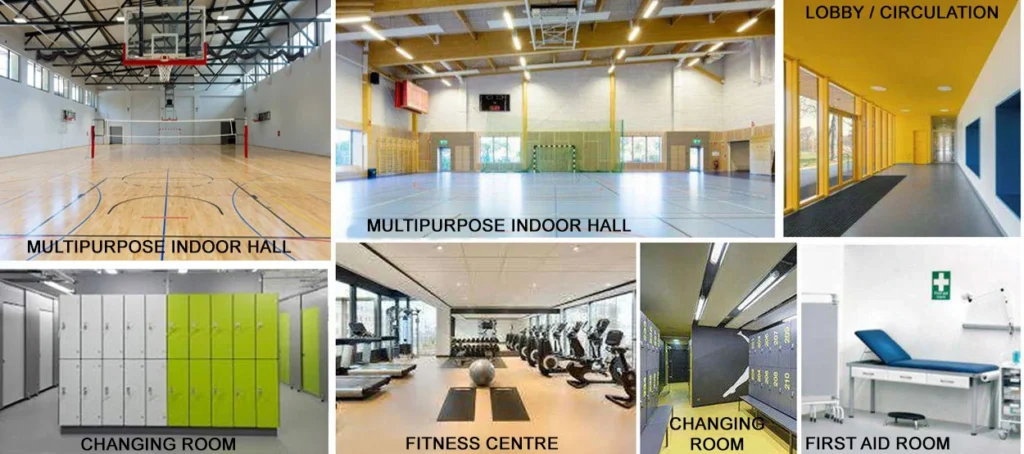
- Main indoor hall (40M X 20M)
- Secondary indoor hall
- Changing rooms – Male and Female
- Yoga / Meditation Hall
- Equipment store
- First Aid / Physiotherapy room
- Lobbies and Circulation spaces
- Fitness Centre
- Admin area
- Juice Bar
4) Multipurpose indoor hall
i) Four court hall
- The optimum dimensions considered for this most popular size of sports hall are 40m x 20m x 9m.
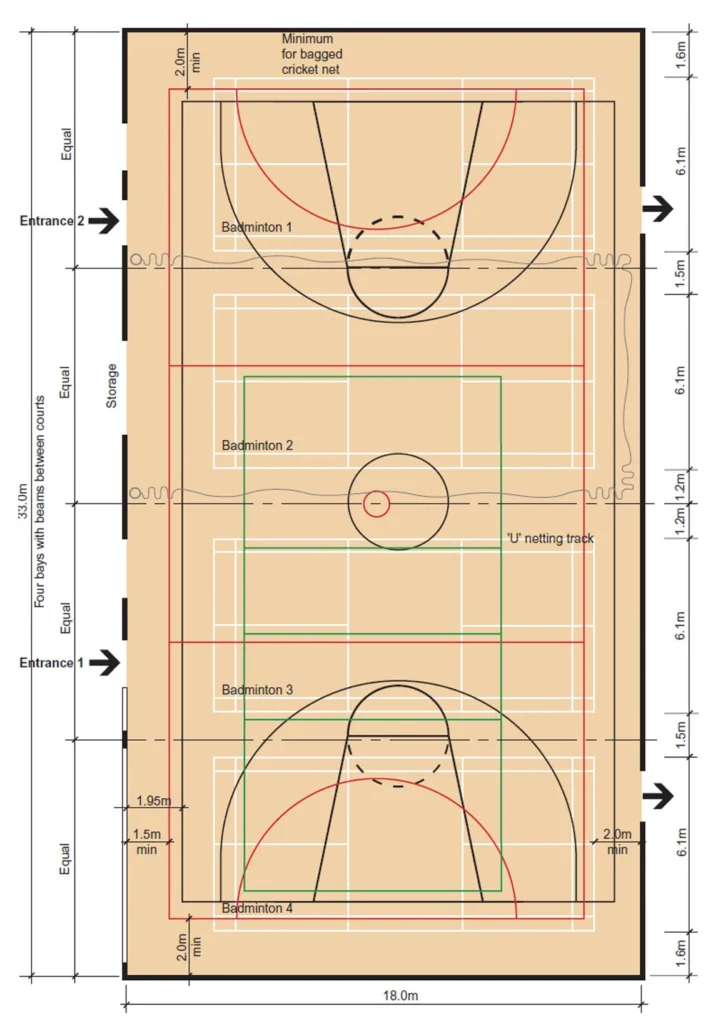
- Main structure must always be aligned between the badminton courts to create four bays.
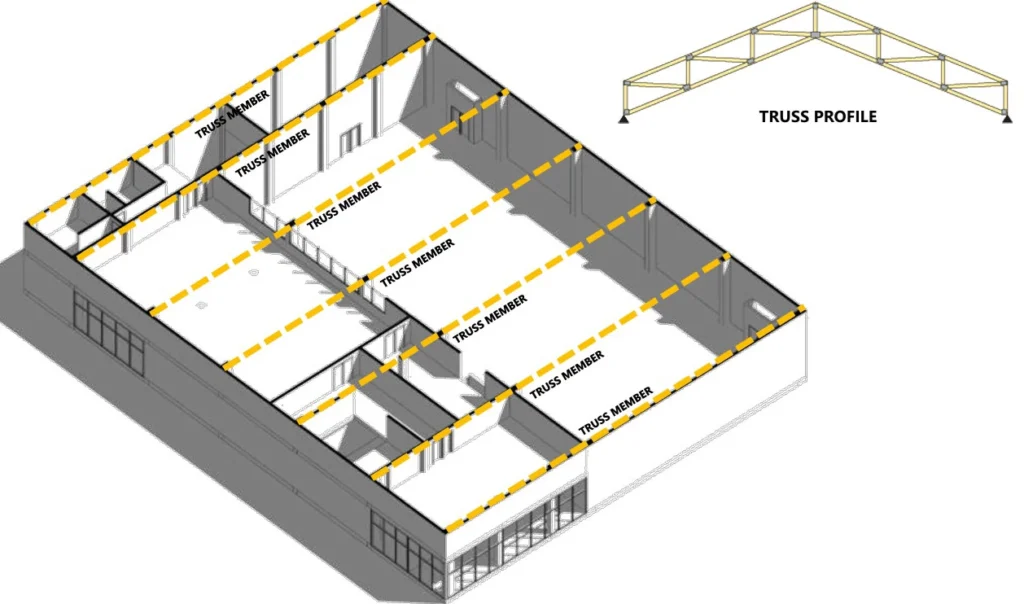
Additional Points
- The space required for most games depends on the standard of play; generally, the higher the standard the larger the space.
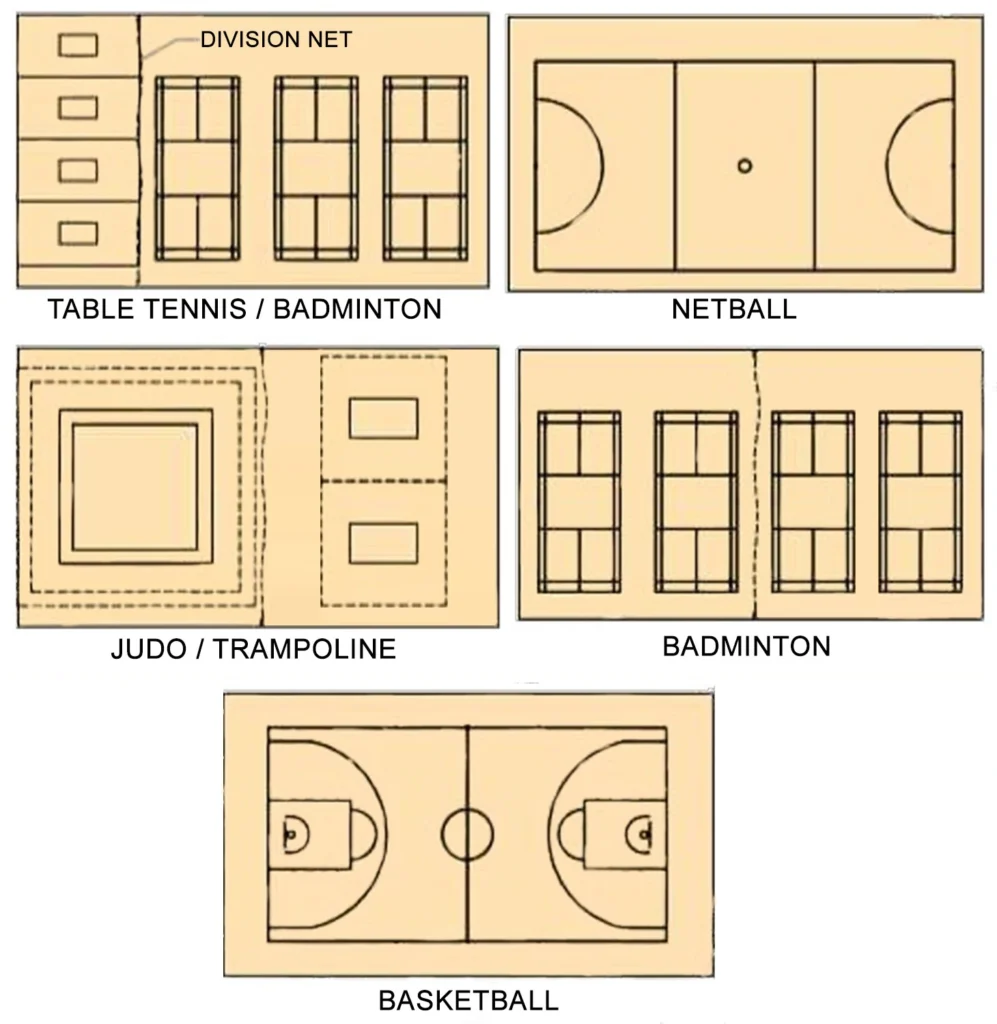
- Fore most competition play an extra zone is required for team benches and an officials’ table and a further security zone between teams and spectators may be required for major events.
ii) Sports to be played: Main Hall
Different sports to be considered for a 40m x 20m size Hall with clear height of 9m.
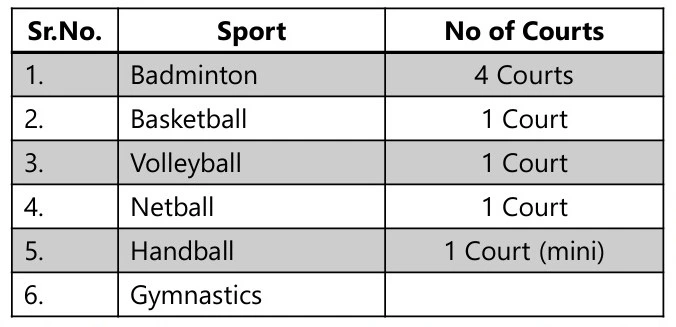
iii) Sports to be played: Secondary Hall
Different sports to be considered for a Secondary Hall with clear height of 5m.
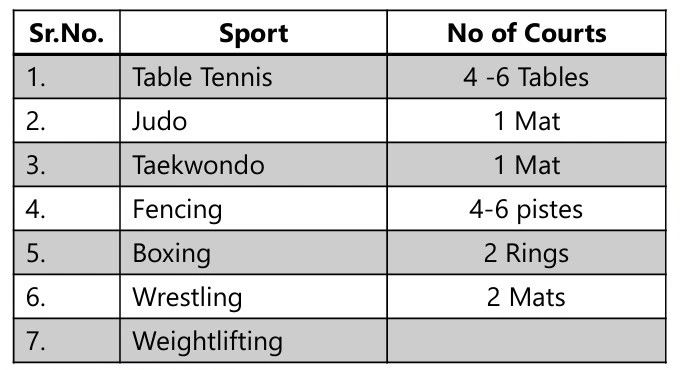
The sports to be played needs to be finalized on the basis of below factors
- Type of flooring
- Field of Play Sizes
- Clear height requirements
- Popularity of a particular sport in respective regions/ areas.
iv) Changing Room Facility
Calculations should take into account : Number of Courts x Maximum number of players per court x 2 ( for changeover)
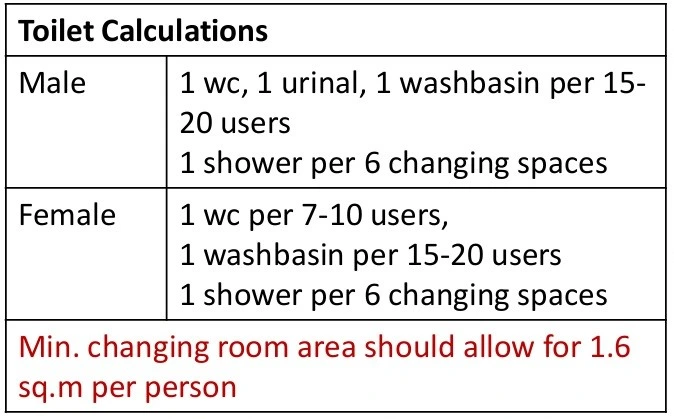
For 4 Court Badminton Hall- 30 changing spaces (each) + Multipurpose Hall-02
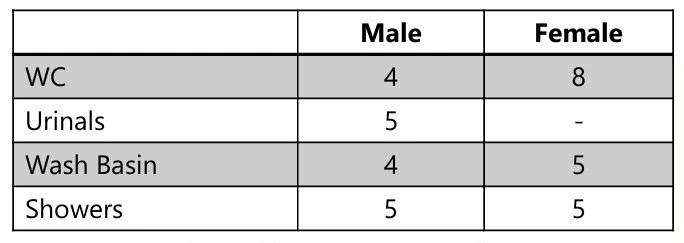
For 2 Court Badminton Hall- 16 changing spaces (each)
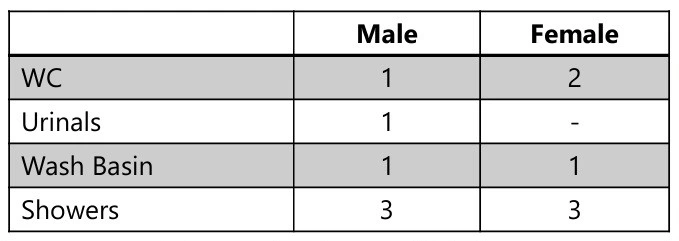
v) Equipment Store
A total of 12.5% of the hall floor area is required as a minimum for sports equipment.
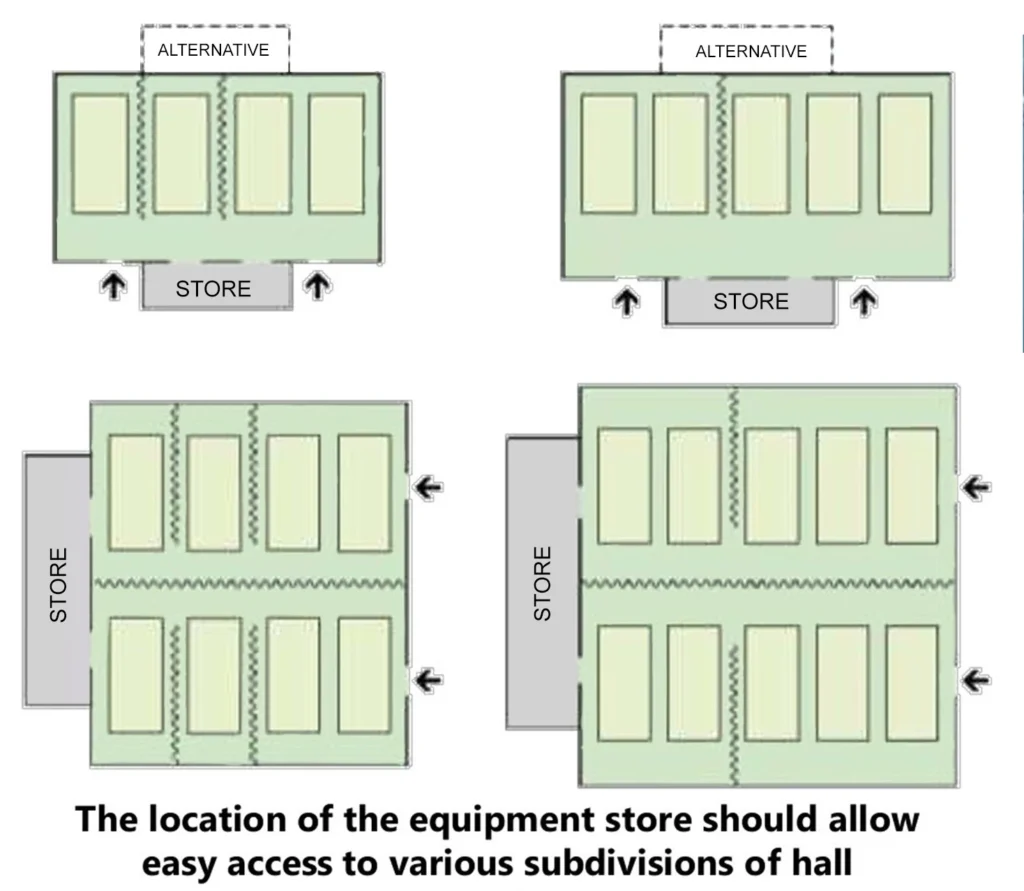
vi) First Aid Room / Physiotherapy Room
A clear space of 2.0 x 1.6 m is recommended as a minimum.
A supply of drinking water should be available and there should be an adjacent accessible toilet facility.
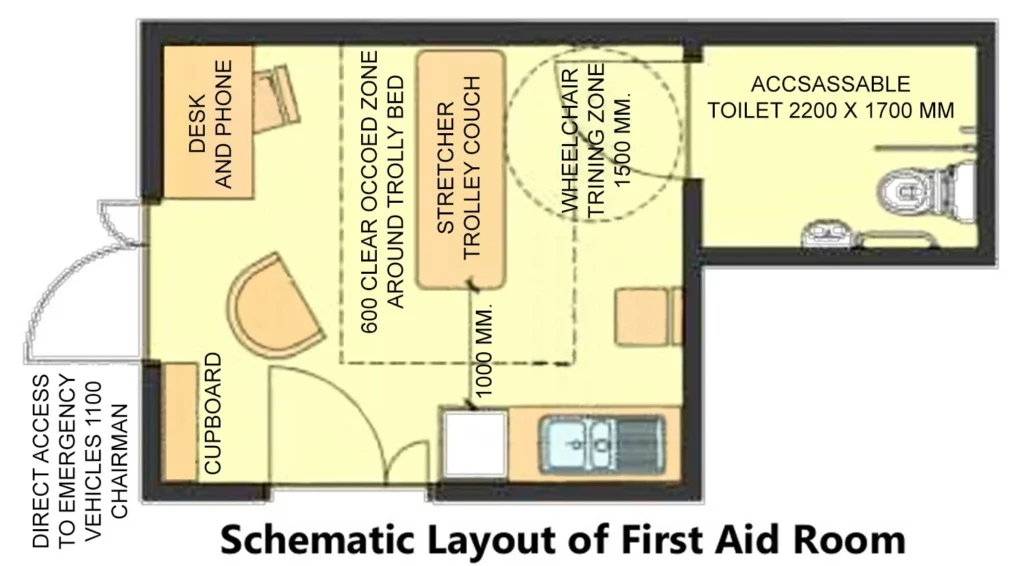
vii) Fitness Centre
The minimum practical floor area is 100 sq.m is the norm for sports center’s.
viii) Admin
The minimum area to provide for 1 cabin and 3 nos. Workstations.
ix) Additional Multipurpose Hall
Ancillary halls can range upwards from a size of 10m x 20m x 5m high for a range of physical and social activities.
5) Technical specifications
i) Flooring
Maple wood with the flooring system and manufacturer approved by FIVB/FIBA/BWF to be provided in the Large Multipurpose Indoor hall is to be used by badminton etc.
Flooring should generally be seamless synthetic Polyurethane flooring over shock absorbing layer as approved by FIVB / FIBA / BWF for longer life and less maintenance can be used in the Fitness and smaller Multipurpose Hall.
Court Markings
Court marking lines are painted on most sports floors.
PVC tape is not usually used, except for temporary courts, whilst inlaid lines are an option for a limited number of sports floor products.
For multi-sports halls a range of colours is required to avoid confusion.

Support Areas
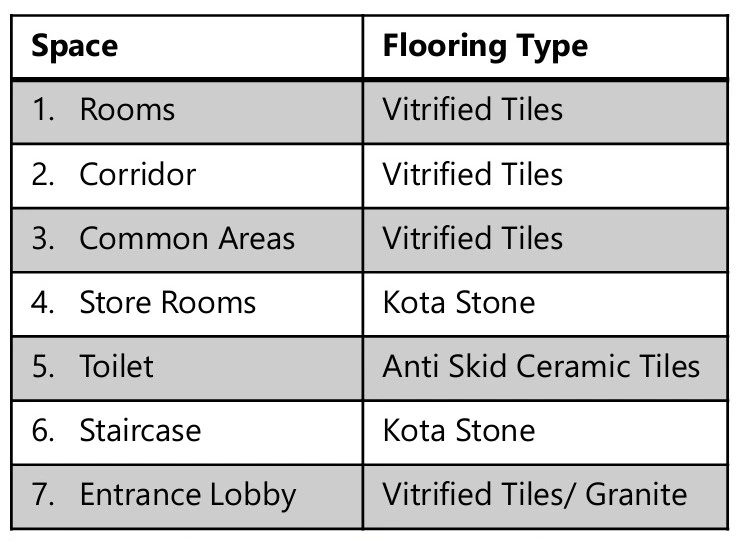
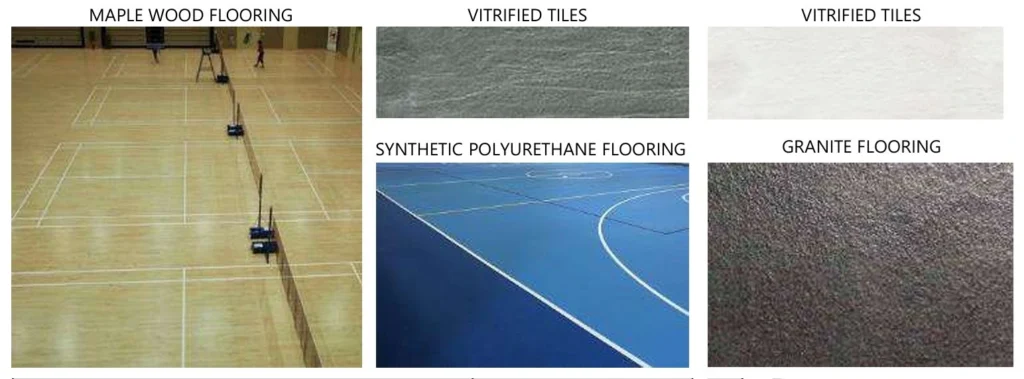
ii) Height
The clear height of the Indoor hall should be minimum required for the training purpose specific to the sports discipline for which it is intended to be used.
Clear height for Combat sports should generally not be more 4.5 to 5 mt depending on the floor area of the hall, for ball games/badminton provide minimum clear height as under.
In case the Indoor hall is likely to hold National/International level completions of ball games, the clear height should be provided as per International federation guidelines.
Clear height requirements considered for different spaces in the facility is mentioned in below table;
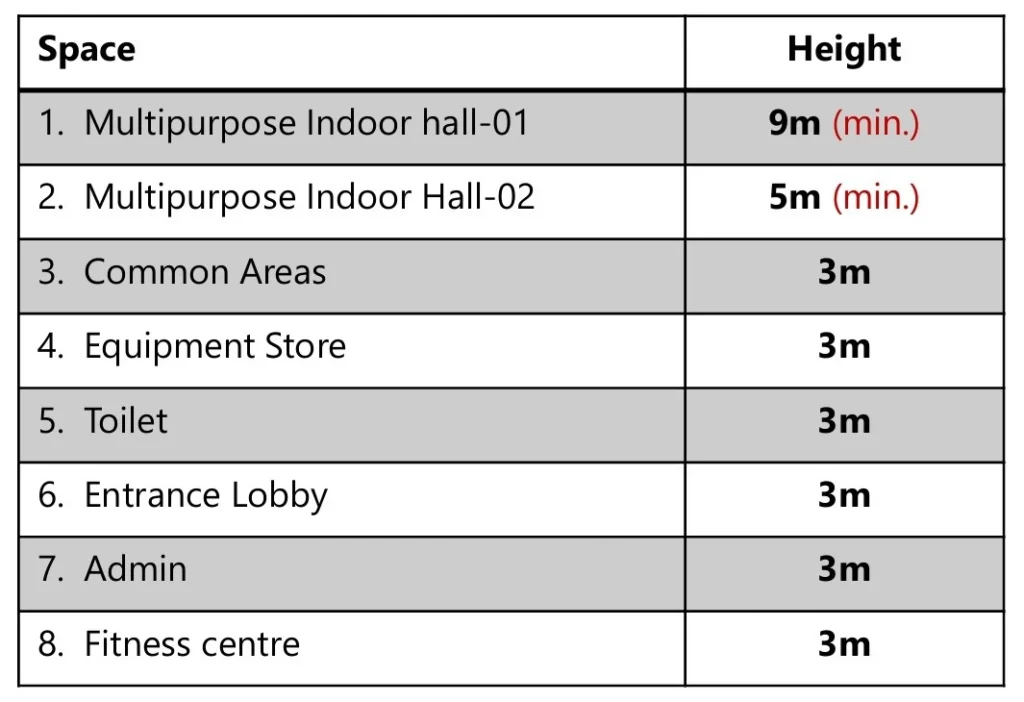
Clear height for various sports discipline has been compiled for different level of sports discipline in below table.
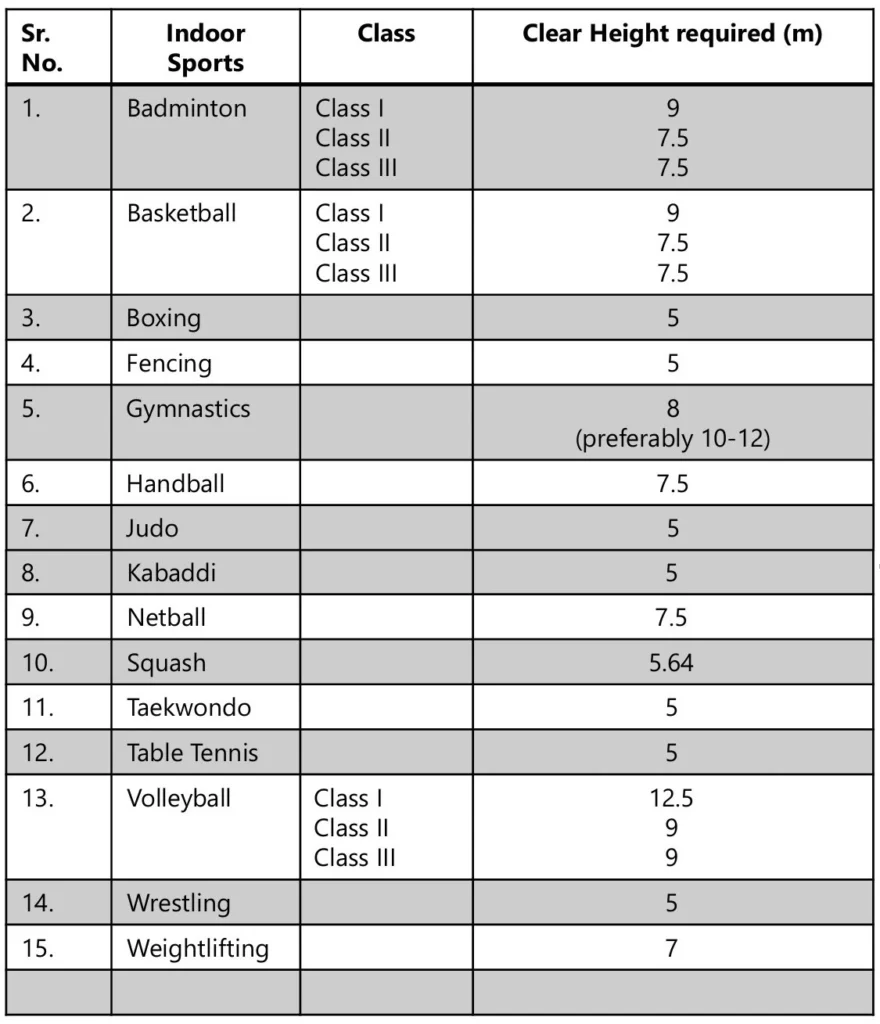
iii) Internal Walls

The internal walls should be flush-faced and impact resistant.
It is preferable if it runs full height and with a consistent colour as horizontal changes in material cause visual obstruction to players
The reflectance value should be generally around 40-50% to give sufficient contrast.
The wall colour should contrast with the floor and be uniform across the wall plane. Preferred Darker colour as shown in contrast to the shuttle / TT ball
Include a 0.15 m skirting designed for easy replacement.

Doors and door frames should be flush with the internal surfaces, and should open outwards away from the sports hall.
Powder Coated Aluminum window
Wooden Flush Door or Powder Coated Metal Door
Flush doors with flush viewing panel opening outwards of sports hall
iv) Ceiling
The roof soffit and structure should:
- Be uniform, preferably white with more than 90% reflectance value
- Where unavoidable, internal linings or suspended ceilings must be impact-resistant
- Suspended ceilings are generally inappropriate for sports halls.
v) Fittings
The hall should be equipped with a range of fixed equipment depending on the chosen priority sports.
Typically this might be:
- Wall- or roof structure -mounted basketball goals with additional practice goals fixed directly to the wall
- Floor and possibly wall sockets with flush fitted cover plates will be required for specific items of equipment
- Wall Protection Cushions at impact points upto 2.1M (Behind Basketball nets etc.)
vi) Acoustics
The internal acoustic conditions within a sports hall should be appropriate for its intended use.
Acoustic design is a complex and specialist subject that can be influenced by many factors such as –
- Reverberation times: The hard surfaces required to withstand impact damage within the sports hall tend not to have good sound absorbency properties and results in sound being repeatedly reflected from the various surfaces. Should be between 1.5 and 2.0 sec at mid-frequency –
- Sound insulation: The level of sound insulation within the building fabric to prevent distracting sound from external sources being transmitted into the hall should also be considered. A standard of NR40 would normally be specified.
The problem can be avoided through acoustic design that integrates sound absorbent materials into the ceiling and/or upper wall levels.
v) Ventilation
No Multipurpose hall will be Air-conditioned unless it is proposed for holding National level competitions.
The ventilation of a sports hall will be required throughout the year.
The fresh air requirement will generally depend on the number of occupants, unless dependent on the cooling needs.
A ventilation rate of approx. 1.5 air changes per hour is adequate for most 4 court sports halls of between 7.0-8.0 m high assuming heat gain or large occupancies are not an issue and that there is good air distribution.
Air velocities should generally be kept below 0.1 m/s with the sports activity volume. This is particularly important for badminton where the flight of the shuttle cocks is likely to be up to 6.0-7.0 m over the court.
A ducted air system has generally been seen as the preferred method of ventilation. It can give a good degree of control of air quality throughout the year and achieve good distribution and efficiency.
vi) Lighting
Natural Lighting
Day lighting in sports halls can cause technical issues that needs to be weighed against the perceived benefits. These include – Controlling glare, Stable & uniform levels of lighting and Heat Gain
Some sports such as badminton have strict advice against daylight in sports halls.
Artificial Sports Lighting
Adequate artificial lighting is an essential element of the sports hall and should be integrated into the design
Many sports halls have to cater for a range of activities and some simultaneously where the sports hall can be divided into sections.
The key issues for lighting design can be summarized as: –
- Illumination value ( Eave) – minimum maintained average: The system should be designed with a higher initial value and for planned replacement of lamps when output falls below the Eave level
- Uniformity ratio (Emin/ Eave): The ration of minimum to average illuminance over the playing area
- Colour rendering (Ra) an indication of the quality /distortion when compared to natural light.
Even Illumination
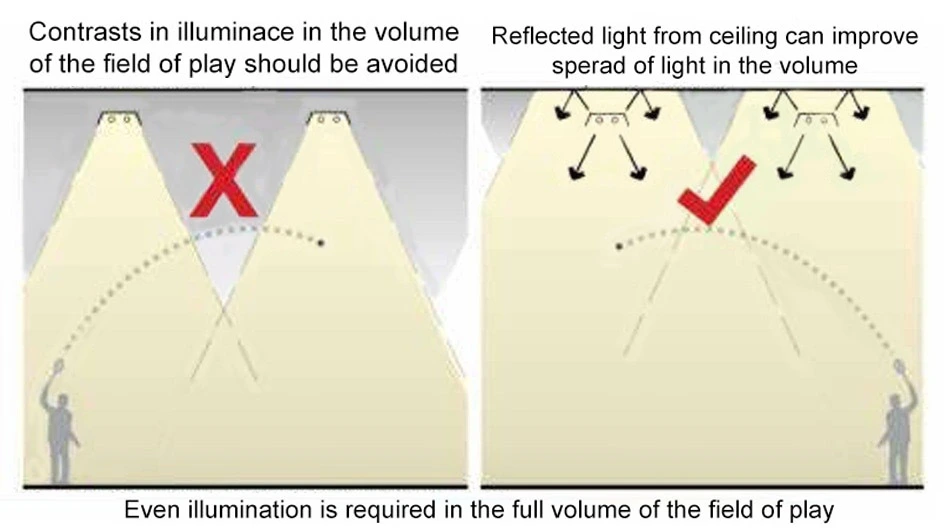
The full volume of the field of play should be illuminated evenly to create equal playing conditions for all players and to create a consistent level of visibility.
Lamp Types
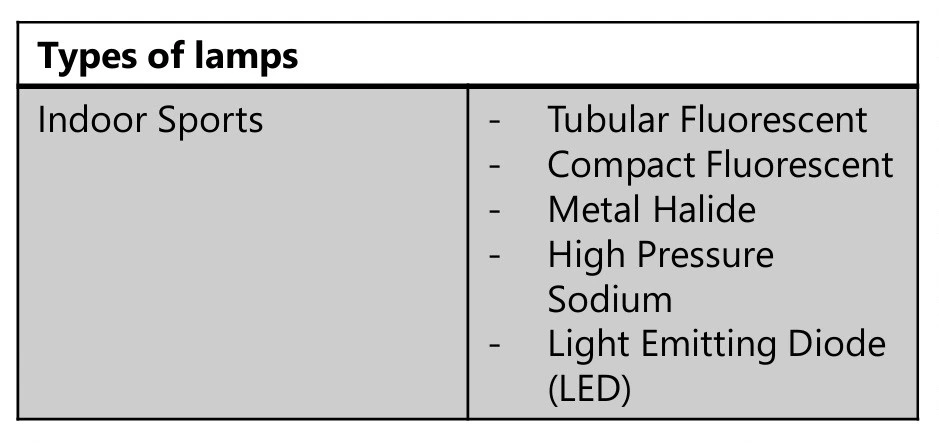
There is a variety of different lamp types used for sports lighting.
Selection is often made on the basis of colour of light emitted, energy consumption and life expectancy.
Levels of Illumination
The level of illumination that is appropriate for a particular sport should be checked with the requirements of the
International Standards.
Glare
Design considerations to be followed to minimize the glare;
- Selection of luminaires designed with attention to the avoidance of glare.
- The locations of the luminaires.
Artificial Lighting Requirements
Minimum lux level requirements for different spaces in the facility is mentioned below;
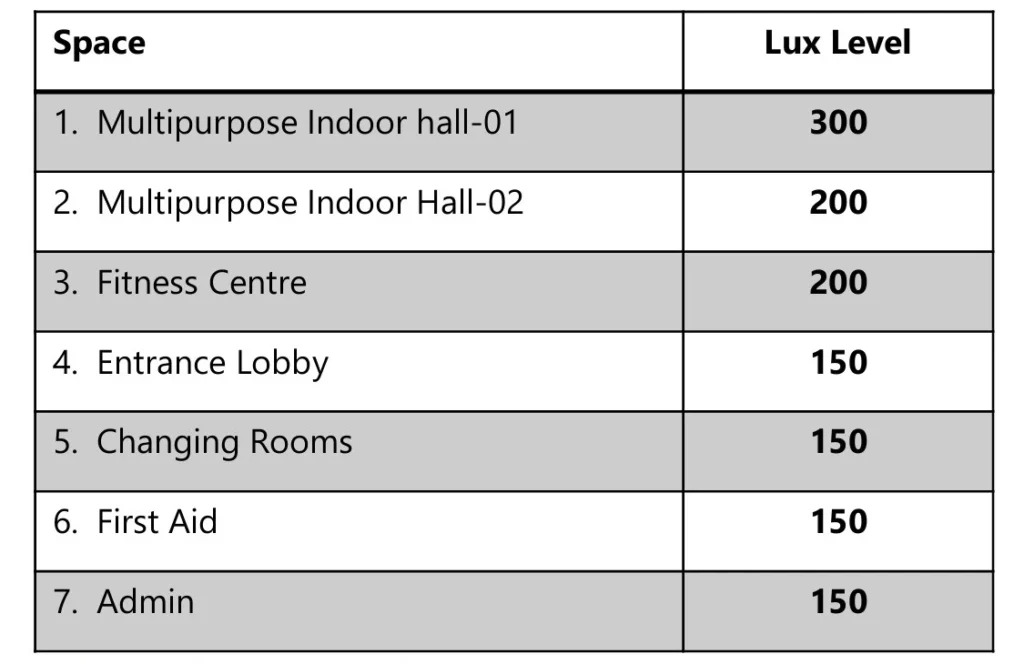
vii) Structure
A multipurpose sports hall must be built to withstand heavy use while ensuring player safety and regulatory compliance. Key Factors in Structural Durability:
- High-Quality Materials – Using reinforced concrete, steel, and impact-resistant glass for long-term durability.
- Weather Resistance – Ensuring the structure can handle temperature fluctuations, humidity, and seismic activity.
- Flooring Durability – Installing surfaces that can handle high foot traffic while reducing wear and tear.
Foundation
Foundations will need to be designed on a site specific basis as the design will depend on the ground
conditions found at the site and the imposed wind loadings.
Floors
The ground floor for the sports hall and ancillary elements of the buildings should be formed of reinforced
concrete.
A damp proof membrane will be required.
Slab thickening and ground beams
Some sports equipment such as volleyball posts require deep support sockets within the floor slab.
These are to enable the sports equipment to be put up and taken down as required and to provide a flush floor surface when they are not in use.
This is typically achieved by casting sockets or connection plates into the ground floor slab.
The floor slab will require localized thickenings under these connection points.
These will need to be designed on a project specific basis as it will depend on the type of sports included and the type of equipment selected.
Superstructure
Continuation of RCC structure till 3m height and mounting of steel columns above for roof truss.
Light weight steel structure for multipurpose hall is ideal.
For Roof, steel truss or portals covered with Insulated Galvalume Roofing sheets are used.
Supporting areas can be designed in rcc or in steel structure depending on site and other factors.
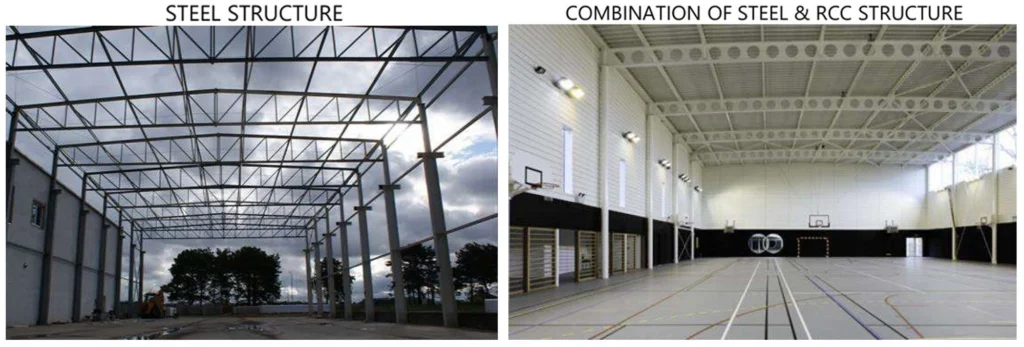
viii) Safety and Accessibility
Exit Routes
The safe evacuation of all people is an essential element of sports facility design and management.
Provide accessible exit routes and final points of exit.
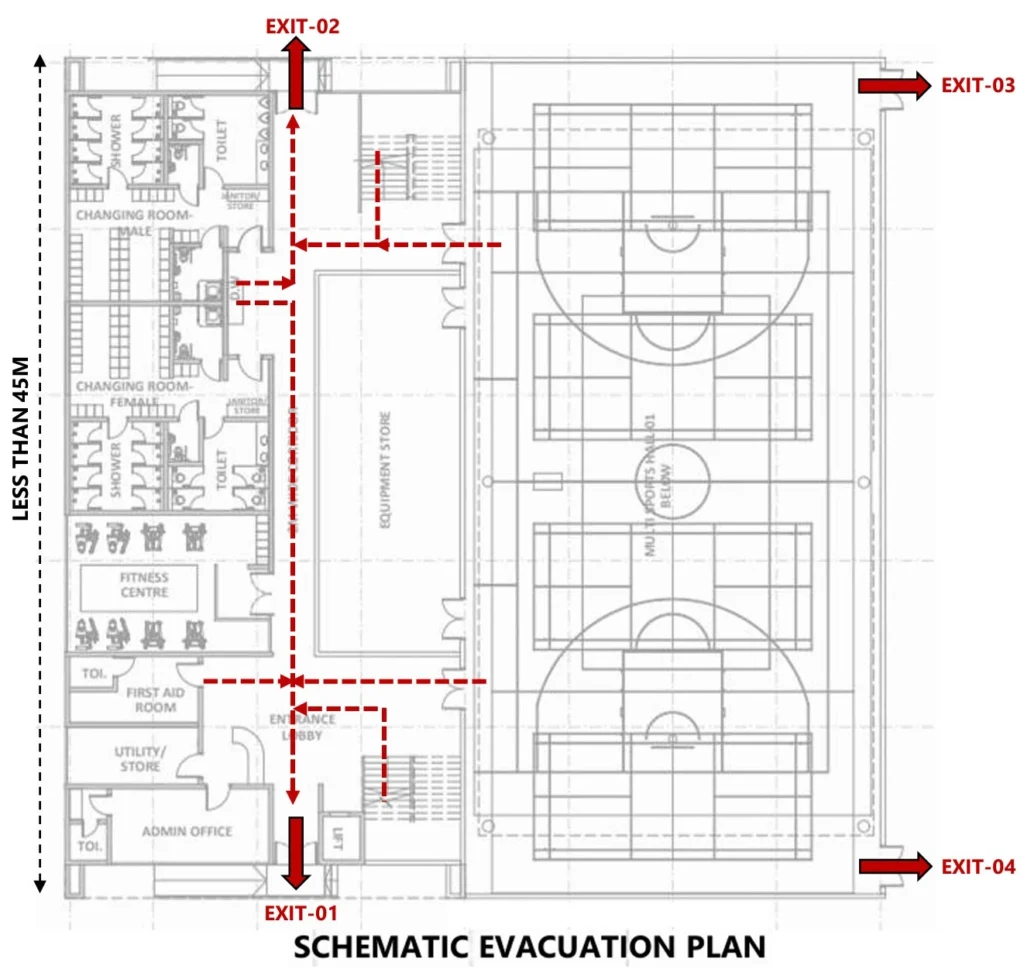
Egress
Clear signage is essential for identification and wayfinding in relation to egress.
Visual and audible communication is required internally and externally to assist people with disabilities.
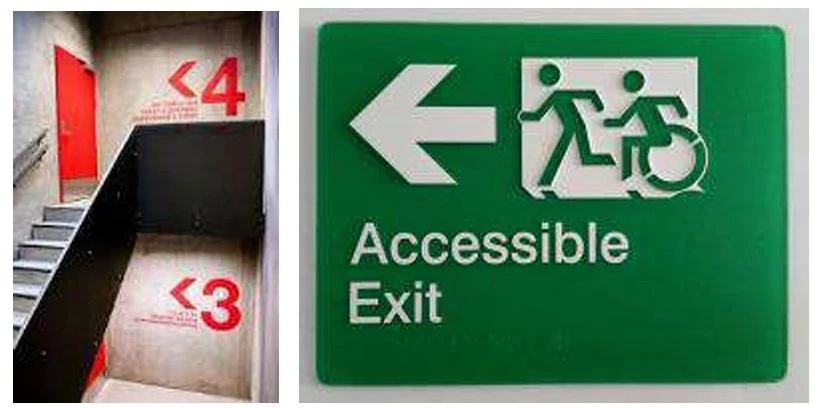
6) Architectural Layout and Space Planning
A well-designed multipurpose sports hall should efficiently manage space, accommodate spectators comfortably, and ensure smooth movement for players, visitors, and staff. The three critical aspects to consider are zoning of different sports areas, flexible seating arrangements, and efficient traffic flow.
Conceptual layout plans with 3d views
Option – 1
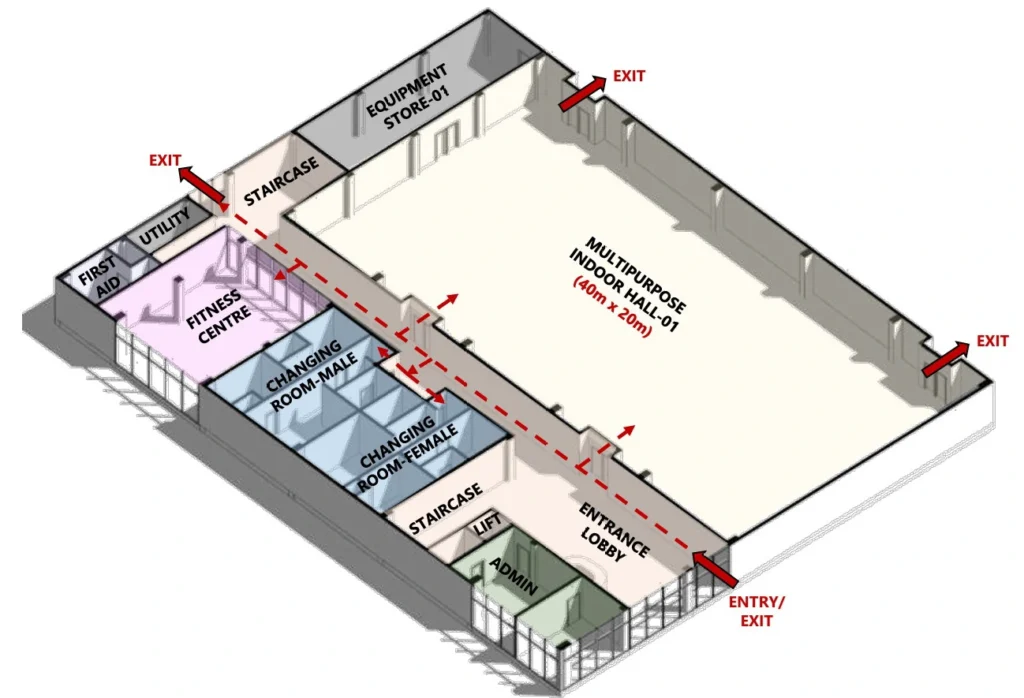
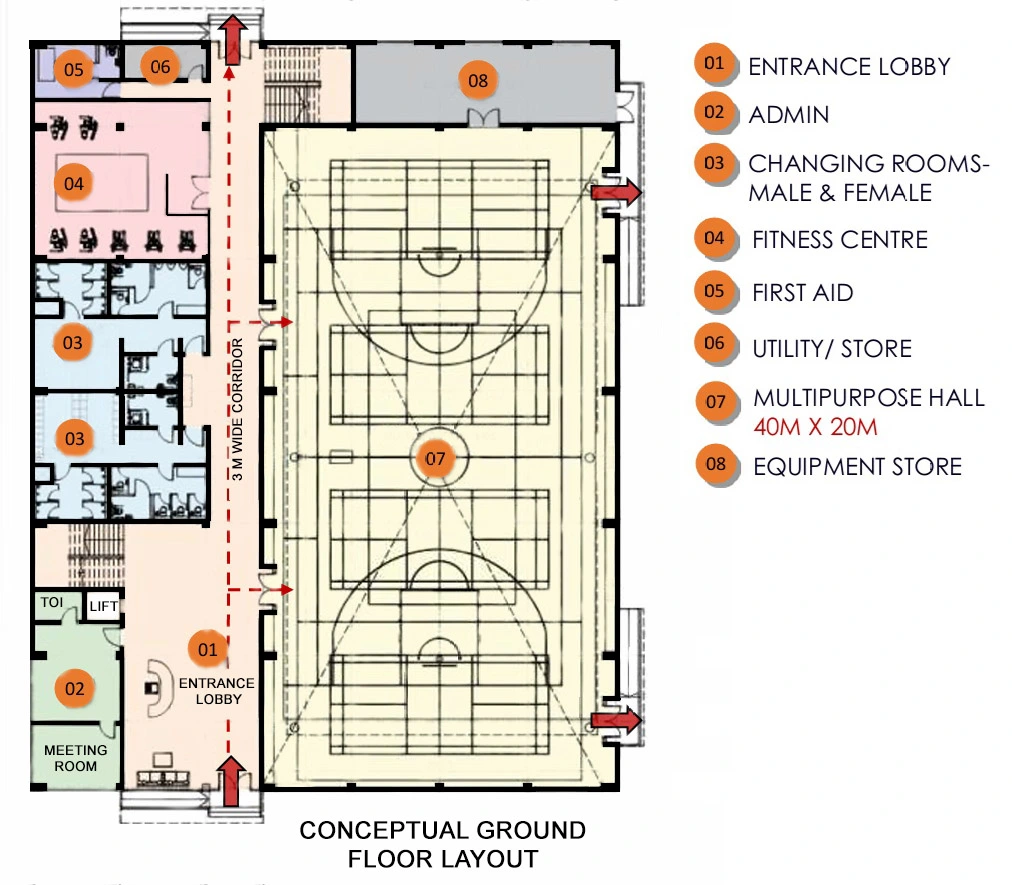
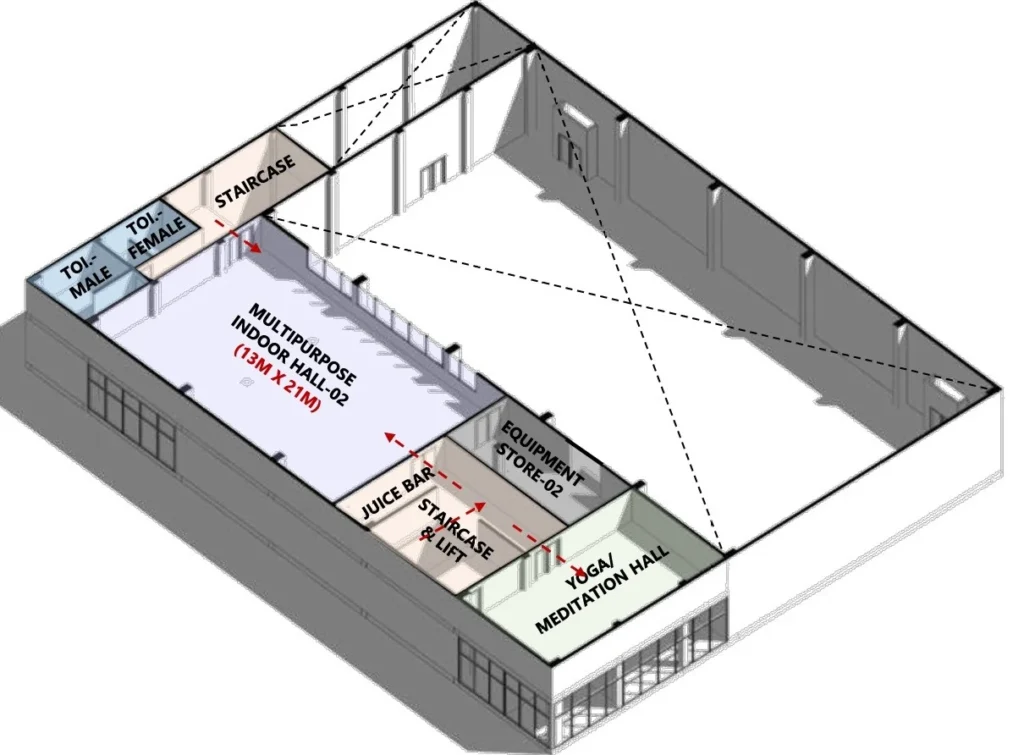
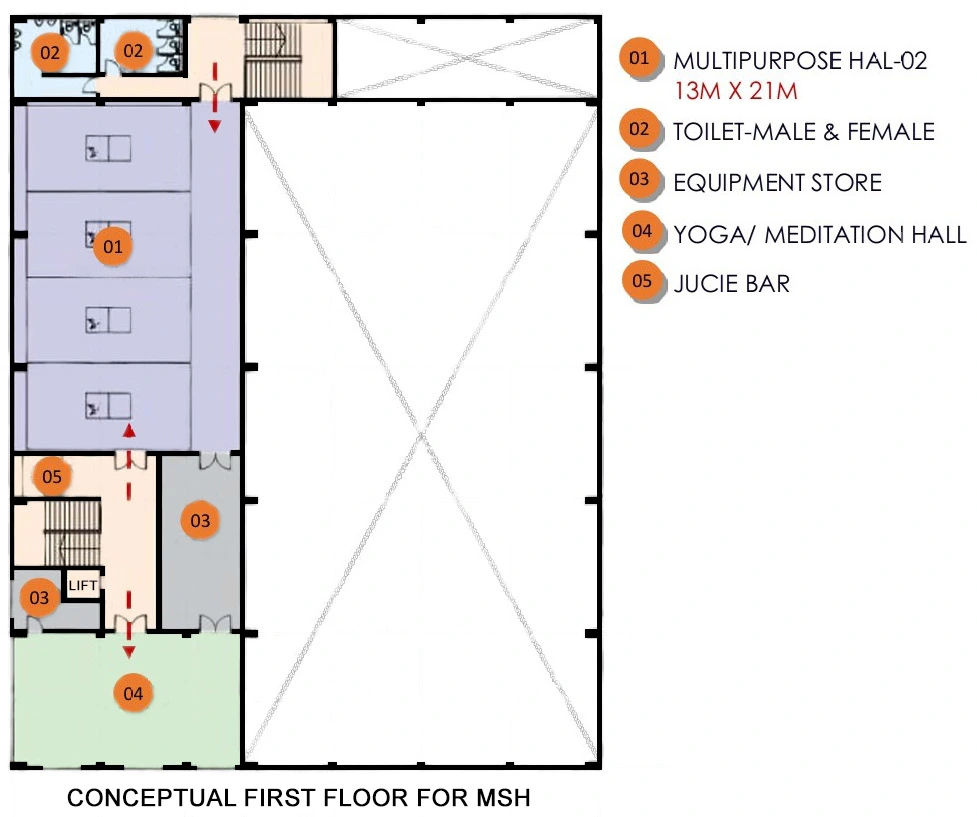
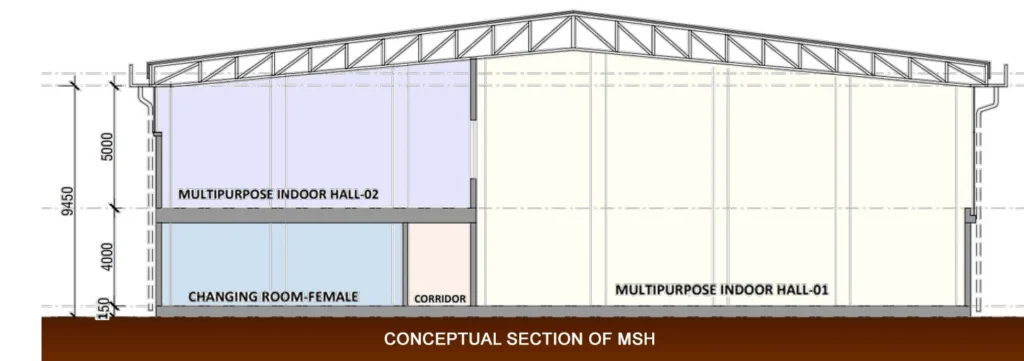
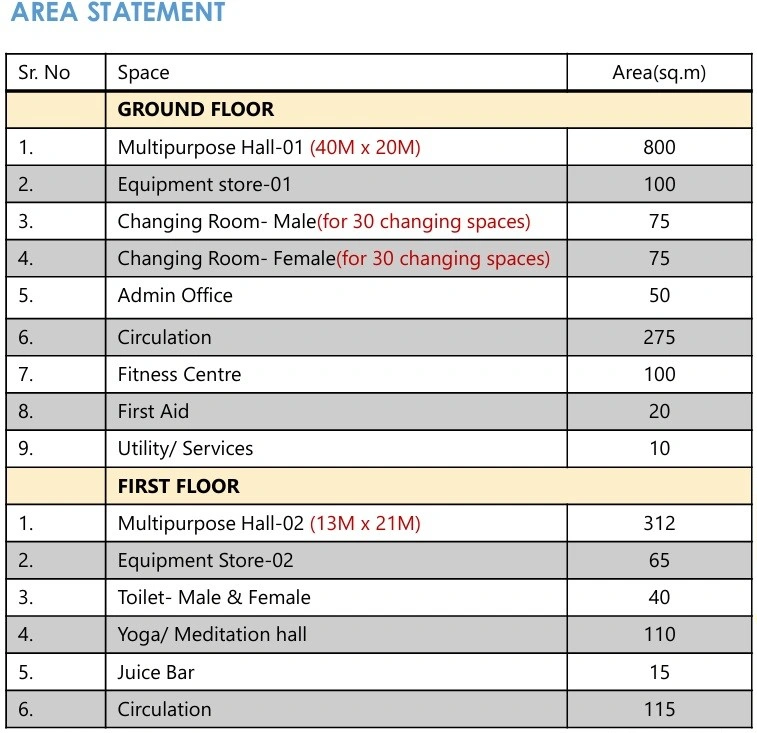
Key Zoning Strategies
Dedicated Zones for Major Sports – Separate courts for basketball, volleyball, badminton, and futsal to avoid overlap.
Multi-Use Areas – Open spaces that can be converted for gymnastics, martial arts, or fitness classes.
Demarcation Lines & Floor Markings – Clearly marked boundaries for each sport to ensure proper space utilization.
Retractable & Movable Partitions – Use of temporary dividers to create smaller or larger play areas as needed.
Storage Areas – Dedicated zones for keeping sports gear, nets, goalposts, and seating when not in use.
Warm-Up & Training Areas – Smaller sections for athletes to practice before games.
Option – 2
